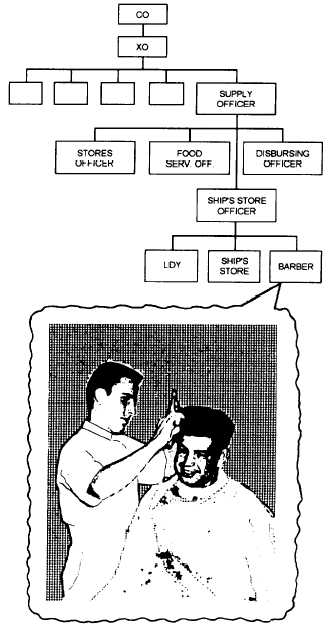| |
sharing your experience,
teammate feel inferior.
but you have not made your
PROVIDING A POSITIVE INFLUENCE
Each individual exerts some influence on all other
members of the team. For example, the member who
always has a “Good morning” for everyone influences
the team to have a positive attitude. However, the
member who always gripes and complains has the
opposite effect.
Each member not only influences the mood of the
team, but also its work habits. Work habits, in turn,
influence the team’s effectiveness in providing service
to the customer. The first of the following examples
shows how a negative influence can affect teamwork;
the second example shows how it can affect customer
service:
A new member reports for duty at your contact
point, and you are the first person the member meets.
After introductions, you feel it is your duty to give the
new member some “survival training.” You begin by
saying, “Senior Petty Officer Door is hard to work for,
especially when she has it in for you. PO Brush won’t
bother you; he’s so lazy it’s an effort for him just to
breathe. SN Frost is an eager beaver, but he is handy to
have around—you can con him into almost anything.”
Giving these opinions places an unfair burden on the
new member. Regardless of whether these statements
were truth or opinion, they will have influenced the new
member’s attitude toward the team.
You are standing at the counter when a customer
walks in, and you ask, “May I help you?” The customer
then presents a problem that involves several actions.
Since you are not sure how to proceed, you ask a
coworker. The coworker only gives you a negative
shake of the head and advice to “ask the chief.” That
doesn’t help much, so you turn back to the customer,
muttering to yourself, “The last time I asked the chief
for help, he told me to look it up myself—he didn’t have
time.” Then to the customer, you say, “Why don’t you
tell the chief your problem; he’ll be able to take care of
it, and he won’t get mad at you.” You have placed the
customer in an uncomfortable position. Your attitude
and negative remarks have influenced the customer to
feel reluctant to talk with the chief. If the customer
chooses not to talk with the chief, the customer will not
receive the needed service.
RECOGNIZING THE VALUE OF EACH JOB
Most contact points have many jobs to perform.
Although team members must be able to perform all jobs
at the contact point, they usually perform only one job
at a time. Although some jobs may seem less important
than others, EACH job is EQUALLY important.
Whether the job is receiving leave requests or preparing
leave authorizations, team members must recognize the
value of each job at the contact point.
To recognize the value of your job, you need to
know its purpose in the overall mission of the contact
point. Ask questions. Find out how the responsibilities
of your job fit into the overall responsibilities of the
contact point. You will then begin to understand the
value of your job and how your performance contributes
to team effort.
4-2
|

